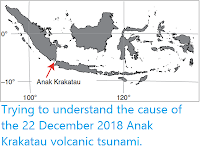Nine people have been killed at an illegal mine in West Sumatra on Saturday 18 April 2020. The nine, described as eight men and a woman, were part of a group of twelve that had entered the abandoned colonial-era mine in South Solon, at the time of the incident, which is believed to have been triggered by heavy rain in the area. Landslides are a common problem after severe weather events, as excess
pore water pressure can overcome cohesion in soil and sediments,
allowing them to flow like liquids. All of the victims are reported to have been local farmers.
The approximate location of the 18 April 2020 South Solon mine accident. Google Maps.
Unlicensed mining operations in Indonesia are notoriously unsafe, and also cause a variety
of environmental problems associated with indiscriminate digging, with
some mining haven taken place inside national parks.
Sumatra
has a wet tropical climate, with a rainy season that lasts from October
to April, when rainfall typically reaches 200-300 mm per month and a
dry season from May to September, when rainfall is usually below 200 mm
per month (though the area is never truly dry. This is driven by the
Southeast Asian Monsoon Seasons, with the Northeast Monsoon driven
by winds from the South China Sea fueling the wetter rainy season and the Southwest Monsoon driven by winds from the southern Indian Ocean the drier dry season. Such a double Monsoon Season is common
close
to the equator, where the Sun is highest overhead around the equinoxes
and lowest on the horizons around the solstices, making the solstices
the coolest part of the year and the equinoxes the hottest.
The winds that drive the Northeast and Southwest Monsoons in Southeast Asia. Mynewshub.
Monsoons
are tropical sea breezes triggered by heating of the land during the
warmer part of the year (summer). Both the land and sea are warmed by
the Sun, but the land has a lower ability to absorb heat, radiating it
back so that the air above landmasses becomes significantly warmer than
that over the sea, causing the air above the land to rise and drawing in
water from over the sea; since this has also been warmed it carries a
high evaporated water content, and brings with it heavy rainfall. In the
tropical dry season the situation is reversed, as the air over the land
cools more rapidly with the seasons, leading to warmer air over the
sea, and thus breezes moving from the shore to the sea (where air is
rising more rapidly) and a drying of the climate.
Diagrammatic representation of wind and rainfall patterns in a tropical monsoon climate. Geosciences/University of Arizona.
See also...
Follow Sciency Thoughts on Facebook.









